Space Shuttle Atlantis
 Atlantis launching on the STS-122 mission to dock with the International Space Station in February 2008 | |
| Construction number | OV-104 |
|---|---|
| Country | United States |
| Contract award | 29 January 1979 |
| Named after | RV Atlantis |
| Status | Retired. Displayed at Kennedy Space Center Visitor Complex in Florida. |
| First flight | STS-51-J 3–7 October 1985 |
| Last flight | STS-135 8–21 July 2011 |
| No. of missions | 33 |
| Crew members | 207[1] |
| Days spent in space | 306 days, 14 hours, 12 minutes, 43 seconds as of STS-135 |
| No. of orbits | 4,848 |
| Distance travelled | 125,935,769 miles (202,673,974 km) as of STS-135 |
| Satellites deployed | 14 |
| Mir dockings | 7 |
| ISS dockings | 12 |
The Space Shuttle Atlantis (Orbiter Vehicle Designation: OV‑104) is a Space Shuttle orbiter belonging to the National Aeronautics and Space Administration (NASA), the spaceflight and space exploration agency of the United States.[2] Constructed by the Rockwell International company in Southern California and delivered to the Kennedy Space Center in Eastern Florida in April 1985, Atlantis is the fourth operational and the second-to-last Space Shuttle built.[3][4] Its maiden flight was STS-51-J from 3 to 7 October 1985.
Atlantis embarked on its 33rd and final mission, also the final mission of a space shuttle, STS-135, on 8 July 2011. STS-134 by Endeavour was expected to be the final flight before STS-135 was authorized in October 2010. STS-135 took advantage of the processing for the STS-335 Launch On Need mission that would have been necessary if STS-134's crew became stranded in orbit.[5] Atlantis landed for the final time at the Kennedy Space Center on 21 July 2011.
By the end of its final mission, Atlantis had orbited the Earth a total of 4,848 times, traveling nearly 126,000,000 mi (203,000,000 km) or more than 525 times the distance from the Earth to the Moon.
Atlantis is named after RV Atlantis, a two-masted sailing ship that operated as the primary research vessel for the Woods Hole Oceanographic Institution from 1930 to 1966.[6]
Construction milestones
| Date | Milestone[7] |
|---|---|
| 29 January 1979 | Contract Award to Rockwell International's Space Transportation Systems Division. |
| 30 March 1980 | Start structural assembly of crew module. |
| 23 November 1981 | Start structural assembly of aft-fuselage. |
| 13 June 1983 | Wings arrive at Palmdale, California, from Grumman. |
| 2 December 1983 | Start of final assembly. |
| 10 April 1984 | Final assembly completed. |
| 6 March 1985 | Rollout from Palmdale. |
| 3 April 1985 | Overland transport from Palmdale to Edwards Air Force Base. |
| 13 April 1985 | Delivery to Kennedy Space Center. |
| 12 September 1985 | Flight Readiness Firing. |
| 3 October 1985 | First flight (STS-51-J). |
Specifications

- Weight (with three shuttle main engines): 151,315 pounds (69 t)
- Length: 122.17 feet (37.2 m)
- Height: 56.58 feet (17.2 m)
- Wingspan: 78.06 feet (23.7 m)
- Atlantis was completed in about half the time it took to build Space Shuttle Columbia.[8]
- When it rolled out of the Palmdale assembly plant, weighing 151,315 lb (68,635 kg), Atlantis was nearly 3.5 short tons (3.2 t) lighter than Columbia. Atlantis is the lightest shuttle of the remaining fleet, weighing three pounds less than the Space Shuttle Endeavour (with the three main engines).
Notable missions

Space Shuttle Atlantis lifted off on its maiden voyage on 3 October 1985, on mission STS-51-J, the second dedicated Department of Defense flight.[9] It flew one other mission, STS-61-B, the second night launch in the shuttle program, before the Space Shuttle Challenger disaster temporarily grounded the shuttle fleet in 1986. Among the five Space Shuttles flown into space, Atlantis conducted a subsequent mission in the shortest time after the previous mission (turnaround time) when it launched in November 1985 on STS-61-B, only 50 days after its previous mission, STS-51-J in October 1985. Atlantis was then used for ten flights between 1988 and 1992. Two of these, both flown in 1989, deployed the planetary probes Magellan to Venus (on STS-30) and Galileo to Jupiter (on STS-34). With STS-30 Atlantis became the first shuttle to launch an interplanetary probe.[10] During another mission, STS-37 flown in 1991, Atlantis deployed the Compton Gamma Ray Observatory. Beginning in 1995 with STS-71, Atlantis made seven straight flights to the former Russian space station Mir as part of the Shuttle-Mir Program. STS-71 marked a number of firsts in human spaceflight: 100th U.S. manned space flight; first U.S. shuttle-Russian Space Station Mir docking and joint on-orbit operations; and first on-orbit changeout of shuttle crew.[11] When linked, Atlantis and Mir together formed the largest spacecraft in orbit at the time.

Shuttle Atlantis also delivered several vital components for the construction of the International Space Station (ISS). During the February 2001 mission STS-98 to the ISS, Atlantis delivered the Destiny Module, the primary operating facility for U.S. research payloads aboard the ISS.[12] The five hour 25 minute third spacewalk performed by astronauts Robert Curbeam and Thomas Jones during STS-98 marked NASA's 100th extra vehicular activity in space.[13] The Quest Joint Airlock, was flown and installed to the ISS by Atlantis during the mission STS-104 in July 2001.[14] The successful installation of the airlock gave on-board space station crews the ability to stage repair and maintenance spacewalks outside the ISS using U.S. EMU or Russian Orlan space suits. The first mission flown by Atlantis after the Space Shuttle Columbia disaster was STS-115, conducted during September 2006.[15] The mission carried the P3/P4 truss segments and solar arrays to the ISS. On ISS assembly flight STS-122 in February 2008, Atlantis delivered the Columbus laboratory to the ISS.[16] Columbus laboratory is the largest single contribution to the ISS made by the European Space Agency (ESA).[17]

In May 2009 Atlantis flew a seven-member crew to the Hubble Space Telescope for its Servicing Mission 4, STS-125.[18] The mission was a success, with the crew completing five space walks totaling 37 hours to install new cameras, batteries, a gyroscope and other components to the telescope.
The longest mission flown using Atlantis was STS-117 which lasted almost 14 days in June 2007.[19] During STS-117, Atlantis' crew added a new starboard truss segment and solar array pair (the S3/S4 truss), folded the P6 array in preparation for its relocation and performed four spacewalks. Atlantis was not equipped to take advantage of the Station-to-Shuttle Power Transfer System so missions could not be extended by making use of power provided by ISS.[20]
During the STS-129 post-flight interview on 16 November 2009 shuttle launch director Mike Leinbach said that Atlantis officially beat shuttle Discovery on the record low amount of Interim Problem Reports, with a total of just 54 listed since returning from the STS-125. He continued to add "It is due to the team and the hardware processing. They just did a great job. The record will probably never be broken again in the history of the Space Shuttle Program, so congratulations to them". During the STS-132 post-launch interview on 14 May 2010, shuttle launch director Mike Leinbach said that Atlantis beat its previous record low amount of Interim Problem Reports, with a total of 46 listed between STS-129 and STS-132.
Orbiter Maintenance Down Periods
Atlantis went through two overhauls of scheduled Orbiter Maintenance Down Periods (OMDPs) during its operational history.
Atlantis arrived at Palmdale, California in October 1992 for OMDP-1. During that visit 165 modifications were made over the next 20 months. These included the installation of a drag chute, new plumbing lines to configure the orbiter for extended duration, more than 800 new heat tiles and blankets and new insulation for main landing gear and structural modifications to the airframe.[21]
On 5 November 1997, Atlantis again arrived at Palmdale for OMDP-2 which was completed on 24 September 1998. The 130 modifications carried out during OMDP-2 included glass cockpit displays, replacement of TACAN navigation with GPS and ISS airlock and docking installation. Several weight reduction modifications were also performed on the orbiter including replacement of Advanced Flexible Reusable Surface Insulation (AFRSI) insulation blankets[22] on upper surfaces with FRSI. Lightweight crew seats were installed and the Extended Duration Orbiter (EDO) package installed on OMDP-1 was removed to lighten Atlantis to better serve its prime mission of servicing the ISS.
During the stand down period post Columbia accident, Atlantis went through over 75 modifications to the orbiter ranging from very minor bolt change-outs to window change-outs and different fluid systems.[23]
Atlantis was known among the shuttle workforce as being more prone than the others in the fleet to problems that needed to be addressed while readying the vehicle for launch leading to some nicknaming it "Britney".[24]
Decommissioning

NASA initially planned to withdraw Atlantis from service in 2008, as the orbiter would have been due to undergo its third scheduled OMDP. However, because of the timescale of the final retirement of the shuttle fleet, this was deemed uneconomical. It was planned that Atlantis would be kept in near-flight condition to be used as a parts hulk for Discovery and Endeavour. However, with the significant planned flight schedule up to 2010, the decision was taken to extend the time between OMDPs, allowing Atlantis to be retained for operations. Atlantis was subsequently swapped for one flight of each Discovery and Endeavour in the flight manifest. Atlantis had completed what was meant to be its last flight, STS-132, prior to the end of the shuttle program,[25] but the extension of the Shuttle program into 2011 led to Atlantis being selected for STS-135, the final Space Shuttle mission in July 2011.

Atlantis is currently displayed at the Kennedy Space Center Visitor Complex.[26] NASA Administrator Charles Bolden announced the decision at an employee event held on 12 April 2011 to commemorate the 30th anniversary of the first shuttle flight: "First, here at the Kennedy Space Center where every shuttle mission and so many other historic human space flights have originated, we'll showcase my old friend, Atlantis."[27][28]
The Visitor Complex displays Atlantis suspended with its payload bay doors opened such that it appears to be back in orbit around the Earth. A multi-story digital projection of Earth rotates behind the orbiter in a 64,000-square-foot (5,900 m2) indoor facility.[29][30] Ground breaking of the facility occurred in 2012.[31] The exhibit opened on 29 June 2013.[32]
Crews

A total of 156 individuals flew with Space Shuttle Atlantis over the course of its 33 missions.[33] Because the shuttle sometimes flew crew members arriving and departing Mir and the ISS, not all of them launched and landed on Atlantis.
Astronaut Clayton Anderson, ESA astronaut Leopold Eyharts and Russian cosmonauts Nikolai Budarin and Anatoly Solovyev only launched on Atlantis. Similarly, astronauts Daniel Tani and Sunita Williams, as well as cosmonauts Vladimir Dezhurov and Gennady Strekalov only landed with Atlantis. Only 146 men and women both launched and landed aboard Atlantis.[citation needed]
Some of those people flew with Atlantis more than once. Taking them into account, 203 total seats were filled over Atlantis' 33 missions. Astronaut Jerry Ross holds the record for the most flights aboard Atlantis at five.[33]
Astronaut Rodolfo Neri Vela who flew aboard Atlantis on STS-61-B mission in 1985 became the first and so far only Mexican to have traveled to space. ESA astronaut Dirk Frimout who flew on STS-45 as a payload specialist was the first Belgian in space. STS-46 mission specialist Claude Nicollier was the first astronaut from Switzerland. On the same flight, astronaut Franco Malerba became the first citizen of Italy to travel to space.
Astronaut Michael Massimino who flew on STS-125 mission became the first person to use Twitter in space in May 2009.[8]
Having flown aboard Atlantis as part of the STS-132 crew in May 2010 and Discovery as part of the STS-133 crew in February/March 2011, Stephen Bowen became the first NASA astronaut to be launched on consecutive missions.[34]
Flights listing
| # | Launch date | Designation | Launch Pad | Landing Location | Duration | Distance[35] | Notes |
|---|---|---|---|---|---|---|---|
| 1 | 3 October 1985 | STS-51-J | 39A | Edwards AFB | 4 days, 1 hour, 44 minutes, 38 seconds | 1,682,641 miles (2,707,948 km) | First Atlantis mission; mission dedicated to Department of Defense. Deployed two DSCS-III (Defense Satellite Communications System) satellites into stationary orbit.[36] |
| 2 | 26 November 1985 | STS-61-B | 39A | Edwards AFB | 6 days, 21 hours, 4 minutes, 49 seconds | 2,466,956 miles (3,970,181 km) | 3 communications satellites deployed: MORELOS-B, AUSSAT-2 and SATCOM KU-2 |
| 3 | 2 December 1988 | STS-27 | 39B | Edwards AFB | 4 days, 9 hours, 5 minutes, 37 seconds | 1,812,075 miles (2,916,252 km) | Mission dedicated to Department of Defense. Deployed the Lacrosse 1 satellite, for the US National Reconnaissance Office (NRO) and the Central Intelligence Agency (CIA). Atlantis' Thermal Protection System tiles sustained unusually severe damage during the flight; over 700 damaged tiles were noted, and one tile was missing.[37] |
| 4 | 4 May 1989 | STS-30 | 39B | Edwards AFB | 4 days, 0 hours, 56 minutes, 28 seconds | 1,477,500 miles (2,377,800 km) | Deployed the Magellan probe bound for Venus. |
| 5 | 18 October 1989 | STS-34 | 39B | Edwards AFB | 4 days, 23 hours, 39 minutes, 20 seconds | 1,800,000 miles (2,900,000 km) | Deployed the Galileo probe bound for Jupiter. |
| 6 | 28 February 1990 | STS-36 | 39A | Edwards AFB | 4 days, 10 hours, 18 minutes, 22 seconds | 1,837,962 miles (2,957,913 km) | Mission dedicated to Department of Defense. STS-36 deployed a single satellite believed to have been a Misty reconnaissance satellite. |
| 7 | 15 November 1990 | STS-38 | 39A | KSC | 4 days, 21 hours, 54 minutes, 31 seconds | 2,045,056 miles (3,291,199 km) | Mission dedicated to Department of Defense. Deployed USA-67 believed to have been a secret Magnum ELINT (ELectronic INTtelligence) gathering satellite. |
| 8 | 5 April 1991 | STS-37 | 39B | Edwards AFB | 5 days, 23 hours, 32 minutes, 44 seconds | 2,487,075 miles (4,002,559 km) | Deployed Compton Gamma Ray Observatory (GRO), the second of the Great Observatories program after the first successful unscheduled EVA in the Shuttle program to deploy GRO's data antenna. |
| 9 | 2 August 1991 | STS-43 | 39A | KSC | 8 days, 21 hours, 21 minutes, 25 seconds | 3,700,400 miles (5,955,200 km) | Deployed Tracking and Data Relay Satellite-5 (TDRS-5 or TDRS-E). |
| 10 | 24 November 1991 | STS-44 | 39A | Edwards AFB | 6 days, 22 hours, 50 minutes, 44 seconds | 2,890,067 miles (4,651,112 km) | Mission dedicated to Department of Defense. The unclassified payload included a Defense Support Program (DSP) satellite deployed on flight day one. |
| 11 | 24 March 1992 | STS-45 | 39A | KSC | 8 days, 22 hours, 9 minutes 28 seconds | 3,274,946 miles (5,270,515 km) | Carried first Atmospheric Laboratory for Applications and Science (ATLAS-1). ATLAS-1 equipped with 12 instruments conducted studies in atmospheric chemistry, solar radiation, space plasma physics and ultraviolet astronomy. |
| 12 | 31 July 1992 | STS-46 | 39A | KSC | 7 days, 23 hours, 15 minutes, 3 seconds | 3,321,007 miles (5,344,643 km) | Deployed the Tethered Satellite System (TSS), a joint NASA/Italian Space Agency experiment. The satellite only reached a maximum of 860 feet (260 m) instead of 12.5 miles (20.1 km), because of a jammed tether line. The European Retrievable Carrier (EURECA) satellite was deployed for the European Space Agency (ESA). |
| 13 | 3 November 1994 | STS-66 | 39B | Edwards AFB | 10 days, 22 hours, 34 minutes, 2 seconds | 4,554,791 miles (7,330,226 km) | Carried Atmospheric Laboratory for Applications and Sciences – 3 (ATLAS-03) to study the energy of the sun and how it affects the Earth's climate and environment. In addition, STS-66 included deployment and retrieval of the Cryogenic Infrared Spectrometer Telescope for Atmosphere (CRISTA) to explore the variability of the atmosphere and provide measurements. |
| 14 | 29 June 1995 | STS-71 | 39A | KSC | 9 days, 19 hours, 22 minutes, 17 seconds | 4,100,000 miles (6,600,000 km) | First shuttle docking with space station Mir. 100th U.S manned space flight. Atlantis transported two cosmonauts Anatoly Solovyev and Nikolai Budarin to Mir and returned astronaut Norman Thagard and cosmonauts Vladimir Dezhurov and Gennady Strekalov. The joint U.S-Russian crew performed life sciences investigations aboard SPACELAB/Mir. |
| 15 | 12 November 1995 | STS-74 | 39A | KSC | 8 days, 4 hours, 31 minutes, 42 seconds | 3,400,000 miles (5,500,000 km) | Carried docking module to Mir and docked to the Kristall module. During the three days of combined shuttle-Mir operations, Atlantis's crew transferred water, supplies, equipment and two new solar arrays to upgrade Mir. |
| 16 | 22 March 1996 | STS-76 | 39B | Edwards AFB | 9 days, 5 hours, 16 minutes, 48 seconds | 3,800,000 miles (6,100,000 km) | Rendezvous with Mir, including crew transfer of Shannon Lucid. STS-76 marked first flight of SPACEHAB pressurized module to support Shuttle-Mir dockings. Spacewalkers Linda Godwin and Michael Clifford conducted the first U.S. extravehicular activity (EVA) around the two mated spacecraft. |
| 17 | 16 September 1996 | STS-79 | 39A | KSC | 10 days, 3 hours, 19 minutes, 28 seconds | 3,900,000 miles (6,300,000 km) | Rendezvous with Mir, including crew transfer of Shannon Lucid and John Blaha. First shuttle mission to the fully completed Mir in its final configuration. STS-79 also marked second flight of SPACEHAB module in support of Shuttle-Mir activities and first flight of SPACEHAB Double Module configuration. |
| 18 | 12 January 1997 | STS-81 | 39B | KSC | 10 days, 4 hours, 56 minutes, 30 seconds | 3,900,000 miles (6,300,000 km) | Rendezvous with Mir, including crew transfer of John Blaha and Jerry Linenger. Carried the SPACEHAB double module and during five days of docked operations with Mir, the crews transferred water and supplies. |
| 19 | 15 May 1997 | STS-84 | 39A | KSC | 9 days, 5 hours, 20 minutes, 47 seconds | 3,600,000 miles (5,800,000 km) | Rendezvous with Mir, including crew transfer of Jerry Linenger and Michael Foale. Carried the SPACEHAB double module. |
| 20 | 25 September 1997 | STS-86 | 39A | KSC | 10 days, 19 hours, 22 minutes, 12 seconds | 4,225,000 miles (6,799,000 km) | Rendezvous with Mir, including crew transfer of Michael Foale and David A. Wolf. Highlights of STS-86 included five days of docked operations and the first joint U.S.-Russian spacewalk during a shuttle mission conducted by cosmonaut Vladimir Titov and astronaut Scott Parazynski. |
| 21 | 19 May 2000 | STS-101 | 39A | KSC | 9 days, 21 hours, 10 minutes, 10 seconds | 5,076,281 miles (8,169,482 km) | International Space Station resupply mission with supplies carried up using a SPACEHAB double module and SPACEHAB Integrated Cargo Carrier pallet. Astronauts James Voss and Jeffrey Williams performed a spacewalk and Atlantis also reboosted the ISS. |
| 22 | 8 September 2000 | STS-106 | 39B | KSC | 11 days, 19 hours, 12 minutes, 15 seconds | 4,919,243 miles (7,916,754 km) | International Space Station resupply mission. STS-106 utilized the SPACEHAB Double Module and the Integrated Cargo Carrier (ICC) to bring supplies to the ISS. The mission also included two spacewalks. |
| 23 | 7 February 2001 | STS-98 | 39A | Edwards AFB | 12 days, 21 hours, 21 minutes | 5,369,576 miles (8,641,495 km) | International Space Station assembly mission (carried and assembled the Destiny Laboratory Module). Three spacewalks including the 100th in the U.S. manned spaceflight program were conducted to complete its assembly. |
| 24 | 12 July 2001 | STS-104 | 39B | KSC | 12 days, 18 hours, 36 minutes, 39 seconds | 5,309,429 miles (8,544,698 km) | International Space Station assembly mission (carried and assembled the Quest Joint Airlock). Astronauts Michael Gernhardt and James Reilly conducted three space walks while Atlantis was docked to the ISS. STS-104 was the first shuttle mission to fly with a "Block II" SSME.[38] |
| 25 | 8 April 2002 | STS-110 | 39B | KSC | 10 days, 19 hours, 43 minutes, 48 seconds | 4,525,299 miles (7,282,763 km) | International Space Station assembly mission (carried and assembled the S0 truss segment) which forms the backbone of the truss structure on the ISS. STS-110 also delivered the Mobile Transporter (MT). Four spacewalks were also conducted in support of ISS construction. |
| 26 | 7 October 2002 | STS-112 | 39B | KSC | 10 days, 19 hours, 58 minutes, 44 seconds | 4,513,015 miles (7,262,994 km) | International Space Station assembly mission (carried and assembled the S1 truss segment). Atlantis also delivered the Crew Equipment Translation Aid (CETA). Astronauts David Wolf and Piers Sellers conducted three spacewalks. A camera mounted to the shuttle's external tank captured the ascent to orbit. This was the first time such footage was recorded.[39][40] |
| 27 | 9 September 2006 | STS-115 | 39B | KSC | 11 days, 19 hours, 6 minutes, 35 seconds | 4,910,288 miles (7,902,343 km) | International Space Station resupply and construction (P3 and P4 truss segments, solar arrays 2A and 4A and batteries). STS-115 was the first assembly mission to the ISS after the Columbia disaster. A total of three spacewalks were performed, during which the crew connected the systems on the installed trusses, prepared them for deployment and did other maintenance work on the ISS. |
| 28 | 8 June 2007 | STS-117 | 39A | Edwards AFB | 13 days, 20 hours, 12 minutes, 44 seconds | 5,809,363 miles (9,349,263 km) | International Space Station resupply and construction (S3 and S4 truss and a set of solar arrays segments)[41] The launch of STS-117 marked the 250th orbital human spaceflight.[42] STS-117 brought Expedition 15 crewmember Clayton Anderson to the ISS, and returned with Sunita Williams. |
| 29 | 7 February 2008 | STS-122 | 39A | KSC | 12 days, 18 hours, 21 minutes, 50 seconds | 5,296,842 miles (8,524,441 km) | International Space Station construction (Columbus laboratory). STS-122 carried ESA astronaut Léopold Eyharts, a French Flight Engineer representing ESA to the ISS and returned Expedition 16 Flight Engineer Daniel M. Tani to Earth. Three spacewalks were performed by mission specialists Rex Walheim and Stanley Love. |
| 30 | 11 May 2009 | STS-125 | 39A | Edwards AFB | 12 days, 21 hours, 37 minutes, 9 seconds | 5,276,000 miles (8,491,000 km) | Final Hubble Space Telescope Servicing Mission 4. Atlantis carried two new instruments to the Hubble Space Telescope, the Cosmic Origins Spectrograph and the Wide Field Camera 3. The mission also replaced a Fine Guidance Sensor, six gyroscopes, and two battery unit modules. The mission included five spacewalks totaling 37 hours. STS-125 carried an IMAX camera to document the progress of the mission. |
| 31 | 16 November 2009 | STS-129 | 39A | KSC | 10 days, 19 hours, 16 minutes, 13 seconds | 4,490,138 miles (7,226,177 km) | International Space Station resupply and construction (ELC-1/ELC-2). STS-129 was the first flight of an ExPRESS Logistics Carrier and focused on staging spare components outside the space station.[43] The mission included three spacewalks. |
| 32 | 14 May 2010 | STS-132 | 39A | KSC | 11 days, 18 hours, 29 minutes, 09 seconds | 4,879,978 miles (7,853,563 km) | International Space Station construction (Mini-Research Module 1 and the cargo pallet, Integrated Cargo Carrier-Vertical Light Deployable (ICC-VLD)).[44] The mission included three spacewalks. |
| 33 | 8 July 2011 | STS-135 | 39A | KSC | 12 days, 18 hours, 28 minutes, 50 seconds | 5,284,862 miles (8,505,161 km) | International Space Station resupply using the Raffaello Multi-Purpose Logistics Module and the Lightweight Multi-Purpose Carrier (LMC). The failed ammonia pump module that was replaced in August 2010 returned inside Atlantis' payload bay. This was the final mission of Space Shuttle Atlantis and the last mission for the Space Shuttle Program. STS-135 flew with a crew of four astronauts; the reduced crew size allowed for rescue by regularly scheduled Soyuz missions if necessary.[45] |
Problems
Composite overwrapped pressure vessels
NASA announced in 2007 that 24 helium and nitrogen gas tanks in Atlantis were older than their designed lifetime. These composite overwrapped pressure vessels (COPV) were designed for a 10-year life and later cleared for an additional 10 years; they exceeded this life in 2005. NASA said it could not guarantee any longer that the vessels on Atlantis would not burst or explode under full pressure. Failure of these tanks could have damaged parts of the orbiter and even wound or kill ground personnel. An in-flight failure of a pressure vessel could have even resulted in the loss of the orbiter and its crew. NASA analyses originally assumed that the vessels would leak before they burst, but new tests showed that they could in fact burst before leaking.
Because the original vendor was no longer in business, and a new manufacturer could not be qualified before 2010, when the shuttles were scheduled to be retired, NASA decided to continue operations with the existing tanks. Therefore, to reduce the risk of failure and the cumulative effects of load, the vessels were maintained at 80 percent of the operating pressure as late in the launch countdown as possible, and the launch pad was cleared of all but essential personnel when pressure was increased to 100 percent. The new launch procedure was employed during some the remaining launches of Atlantis,[46] but was resolved when the two COPVs deemed to have the highest risk of failure were replaced.[47]
Window damage
After the STS-125 mission, a work light knob was discovered jammed in the space between one of Atlantis's front interior windows and the Orbiter dashboard structure. The knob was believed to have entered the space during flight, when the pressurized Orbiter was expanded to its maximum size. Then, once back on Earth, the Orbiter contracted, jamming the knob in place. Leaving "as-is" was considered unsafe for flight, and some options for removal (including window replacement) would have included a 6-month delay of Atlantis's next mission (planned to be STS-129). Had the removal of the knob been unsuccessful, the worst-case scenario was that Atlantis could have been retired from the fleet, leaving Discovery and Endeavour to complete the manifest alone. On 29 June 2009, Atlantis was pressurized to 17 psi (120 kPa) (3 psi above ambient), which forced the Orbiter to expand slightly. The knob was then frozen with dry ice, and successfully removed.[48] Small areas of damage to the window were discovered where the edges of the knob had been embedded into the pane.[49] Subsequent investigation of the window damage discovered a maximum defect depth of approximately 0.0003 in (7.6 μm), less than the reportable depth threshold of 0.0015 in (38 μm) and not serious enough to warrant the pane’s replacement.[50]
Gallery
 |
 |
 |
 |
| Liftoff of first flight of Atlantis and the STS-51-J mission. | Deployment of the Magellan space probe to Venus on STS-30. | Underside view of Atlantis during STS-117 as it approached the International Space Station and performed a Rendezvous Pitch Maneuver. | Atlantis landing at the Kennedy Space Center following STS-122. |
 |
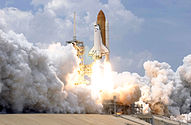 |
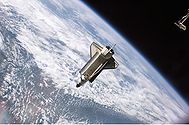 |
 |
| Atlantis carrying the S1 Truss segment on mission STS-112. | Atlantis and its STS-125 crew head toward Earth orbit and rendezvous with the Hubble Space Telescope. | Space Shuttle Atlantis after it undocked from the International Space Station on 17 September 2006. | The Space Shuttle Atlantis landing in 1997, at the end of STS-86. |
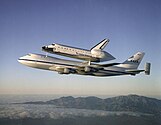 |
 |
 |
 |
| Atlantis on top of the Shuttle Carrier Aircraft in 1998. | An overhead view of Atlantis as it sits atop the Mobile Launcher Platform before STS-79. | An overhead image of Atlantis during STS-115, as recorded by an Expedition 13 crew member on board the International Space Station | The Hubble Space Telescope aboard Atlantis during the STS-125 mission |
 |
 |
||
| Atlantis' final landing at the end of the STS-135 mission. | Atlantis in its final exhibit display at Kennedy Space Center Visitor Complex |
Tribute and mission insignias
| NASA Orbiter Tribute for Space Shuttle Atlantis | ||||||
|---|---|---|---|---|---|---|
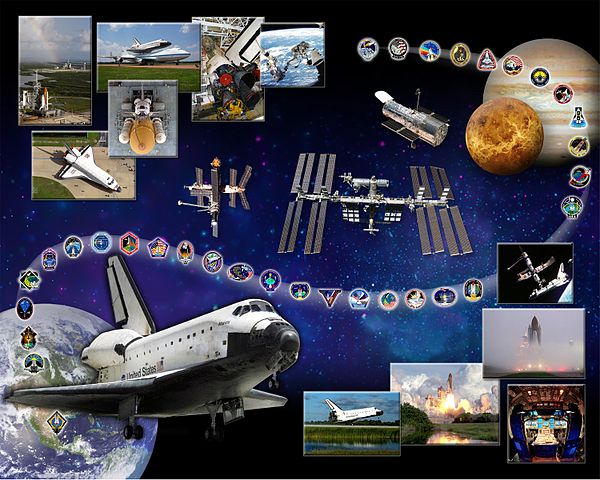 | ||||||
| Mission insignia for Atlantis flights | ||||||
 |
 |
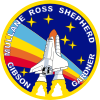 |
 |
 |
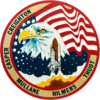 |
 |
 |
 |
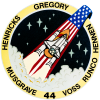 |
 |
 |
 |
 |
 |
 |
 |
 |
 |
 |
 |
 |
 |
 |
 |
 |
 |
 |
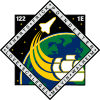 |
 |
 |
 |
 |
||
In media
Atlantis was the shuttle shown in the 1986 film SpaceCamp, starring Kate Capshaw, Lea Thompson, Tom Skerritt and Joaquin Phoenix. The premise of the film was a crew of students at United States Space Camp that are accidentally launched into space on-board Atlantis. Atlantis was also featured in the 1998 film Deep Impact as the spacecraft used to shuttle the crew to the fictional Messiah spacecraft. It is also featured in Armageddon, a film with a similar plot, in which the shuttle is destroyed in a rogue meteor shower. She is involved as well in The Dig, a 1995 science fiction adventure game.
See also
- List of human spaceflights
- List of Space Shuttle crews
- List of space shuttle missions
- Timeline of Space Shuttle missions
- STS-135
References
- ^ Chris Gebhardt (31 December 2011). "Year in Review – Part 4: Saying Goodbye to Discovery, Atlantis, and Endeavour". www.spaceflight.com. Retrieved 1 January 2012.
- ^ NASA (2007). "Space Shuttle Overview: Atlantis (OV-104)". National Aeronautics and Space Administration. Retrieved 6 November 2007.
- ^ Justin Ray (11 May 2010). "Respecting Atlantis as the shuttle faces retirement". Spaceflight Now. Retrieved 13 May 2010.
- ^ Peter W. Merlin (20 May 2010). "Space Shuttle Atlantis Wraps Up 25-year Career". NASA. Retrieved 25 July 2010.
- ^ Svitak, Amy (19 November 2010). "Bolden Says Extra Shuttle Flight Needed As Hedge Against Additional COTS Delays". Space News International. Retrieved 16 March 2011.
- ^ "Space Shuttle Atlantis Orbitor Fleet". Retrieved 23 September 2008.
- ^ "Atlantis (OV‑103)". Retrieved 17 February 2012.
- ^ a b "Space Shuttle Atlantis facts". Florida Today. 9 April 2011. Retrieved 29 April 2011.
- ^ "Space shuttle Atlantis moves to launch pad for final planned flight". Collect SPACE. 22 April 2010. Retrieved 25 July 2010.
- ^ Karen Rowan (12 May 2010). "7 Cool Things You Didn't Know About Space Shuttle Atlantis". SPACE.com. Retrieved 13 May 2010.
- ^ NASA. "STS-71". Retrieved 25 July 2010.
- ^ Todd Halvorson. "Destiny Fulfilled: Atlantis Ends Mission With Safe Touchdown". SPACE.com. Retrieved 25 July 2010.
- ^ Todd Halvorson (14 February 2010). "Astronauts Cap 100th Spacewalk With Successful Disaster Drill". SPACE.com. Retrieved 25 July 2010.
- ^ William Harwood (15 July 2001). "Airlock marks milestone in quest to assemble Alpha". Spaceflight Now. Retrieved 25 July 2010.
- ^ NASA (28 September 2006). "STS-115: A Mission to Build On". Retrieved 25 July 2010.
- ^ Dave Mosher (7 February 2008). "Europeans Celebrate Successful Launch of Science Lab". SPACE.com. Retrieved 25 July 2010.
- ^ European Space Agency. "Columbus laboratory". Retrieved 25 July 2010.
- ^ NASA (29 May 2009). "Mission Accomplished: Leaving Hubble Better Than Ever". Retrieved 25 July 2010.
- ^ NASA (22 June 2007). "STS-117 MCC Status Report #30". Retrieved 25 July 2010.
- ^ "Preflight Interview: Stan Love, Mission Specialist". NASA. 19 November 2007.
- ^ "Atlantis (OV-104)". NASA. 10 October 2009.
- ^ "Advanced Flexible Reusable Surface Insulation Blankets". NASA.gov. 10 October 2009.
- ^ NASA (22 August 2006). "Mike Leinbach, STS-115 Launch Director". Retrieved 25 July 2010.
- ^ STS-135: Engineers retest MFV – ET-138 stringer inspections completed | NASASpaceFlight.com
- ^ Bergin, Chris (23 June 2007). "Atlantis avoids early retirement – will keep flying to 2010". NASASpaceflight.com.
- ^ "NYC, L.A., Kennedy Space Center, Smithsonian to get the 4 retired space shuttles". USA Today. 12 April 2011.
- ^ William Harwood (12 April 2011). "Space shuttle retirement museums announced". Spaceflight NOW. Retrieved 13 April 2011.
- ^ Matthew Travis (12 April 2011). "Homes of Retired Space Shuttle Orbiters Announcement by NASA Admin Charlie Bolden". SpaceflightNews.net. Retrieved 23 June 2011.
- ^ Robert Z. Pearlman (12 April 2011). "NASA Gives Space Shuttles to Smithsonian and Museums in Calif., Florida and NYC". CollectSPACE.com. Retrieved 13 April 2011.
- ^ NASA (12 April 2011). "NASA to Enhance Shuttle Story at Kennedy with Atlantis". Retrieved 13 April 2011.
- ^ "There's No Space Like Home. Welcome Home, Atlantis!". Retrieved 14 April 2010.
- ^ "Space shuttle Atlantis exhibit opens June 29". CFN13. Retrieved 21 February 2013.
- ^ a b "The legacy of space shuttle Atlantis". CollectSPACE. 2 June 2010. Retrieved 4 June 2010.
- ^ "NASA'S Shuttle Discovery Heads To Space Station On Its Final Mission". NASA. 24 February 2011. Retrieved 10 March 2011.
- ^ NASA (May 2010). "Space Shuttle Mission STS-132 Press Kit" (PDF).
- ^ Day, Dwayne (4 January 2010). "A lighter shade of black: the (non) mystery of STS-51J". The Space Review. Retrieved 21 July 2011.
- ^ William Harwood (27 March 2009). "Legendary commander tells story of shuttle's close call". Spaceflight Now. Retrieved 25 July 2010..
- ^ G. D. Hopson (28 June 2001). "Atlantis STS 104 Space Shuttle Program SSME Flight Readiness Review" (PDF). Retrieved 25 July 2010.
- ^ Stephen Clark (12 September 2002). "Sneak peek at 'shuttlecam'". Spaceflight Now. Retrieved 25 July 2010.
- ^ NASA. "STS 112 Daily Videos: Flight Day 1". Retrieved 25 July 2010.
- ^ Harwood, William (2007). "STS-117 Mission Coverage". CBS News. Spaceflightnow.com. Retrieved 7 December 2007.
- ^ "STS-117 marks 250th orbital crewed flight". collectSPACE.
- ^ Elaine M. Marconi (4 December 2009). "Mission STS-129: Delivering the Goods". NASA.gov. Retrieved 25 July 2010.
- ^ William Harwood (12 May 2010). "Mission preview: Atlantis to launch Russian mini module". Spaceflight Now. Retrieved 25 July 2010.
- ^ Bergin, Chris (20 August 2010). "NASA managers approve STS-135 mission planning for June 28, 2011 launch". NASASpaceflight.com. Retrieved 16 March 2011.
- ^ Halvorson, Todd; Kelly, John (2007). "Orbiters Feel Pains of Aging". Florida Today. Space.com. Retrieved 6 November 2007.
- ^ Chris Gebhardt. "NASA Reviews COPV Reliability Concerns for Final Program Flights". NASASpaceflight.com. Retrieved 19 July 2010.
- ^ Bergin, Chris (2009). "Knob removed, Atlantis window inspection begins – longerons in cart accident". NASASpaceflight.com. Retrieved 30 June 2009.
- ^ Bergin, Chris (2009). "Window damage on Atlantis threatens six month delay to STS-129". NASASpaceflight.com. Retrieved 25 June 2009.
- ^ Bergin, Chris (2009). "Endeavour heads into countdown – Atlantis window damage cleared". NASASpaceflight.com. Retrieved 31 July 2009.
External links
- Orbiter Vehicles
- Shuttle Orbiter Atlantis (OV-104)
- 16 April 2007: Consolidated Launch Manifest: Space Shuttle Flights and ISS Assembly Sequence
- Space Shuttle Atlantis: Last Flight – slideshow by Life magazine
- Atlantis photo essay From Boston.com.
- Transition & Retirement: Hi-res spherical panoramas of the processing
- Atlantis StickrBoo



